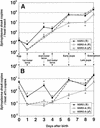Population dynamics of male-killing and non-male-killing spiroplasmas in Drosophila melanogaster
- PMID: 12620825
- PMCID: PMC150097
- DOI: 10.1128/AEM.69.3.1428-1434.2003
Population dynamics of male-killing and non-male-killing spiroplasmas in Drosophila melanogaster
Abstract
The endosymbiotic bacteria Spiroplasma spp. are vertically transmitted through female hosts and are known to cause selective death of male offspring in insects. One strain of spiroplasma, NSRO, causes male killing in Drosophila species, and a non-male-killing variant of NSRO, designated NSRO-A, has been isolated. It is not known why NSRO-A does not kill males. In an attempt to understand the mechanism of male killing, we investigated the population dynamics of NSRO and NSRO-A throughout the developmental course of the laboratory host Drosophila melanogaster by using a quantitative PCR technique. In the early development of the host insect, the titers of NSRO were significantly higher than those of NSRO-A at the first- and second-instar stages, whereas at the egg, third-instar, and pupal stages, the titers of the two spiroplasmas were almost the same. Upon adult emergence, the titers of the two spiroplasmas were similar, around 2 x 10(8) dnaA copy equivalents. However, throughout host aging, the two spiroplasmas showed strikingly different population growth patterns. The titers of NSRO increased exponentially for 3 weeks, attained a peak value of around 4 x 10(9) dnaA copy equivalents per insect, and then decreased. In contrast, the titers of NSRO-A were almost constant throughout the adult portion of the life cycle. In adult females, consequently, the titer of NSRO was significantly higher than the titer of NSRO-A except for a short period just after emergence. Although infection of adult females with NSRO resulted in almost 100% male killing, production of some male offspring was observed within 4 days after emergence when the titers of NSRO were as low as those of NSRO-A. Based on these results, we proposed a threshold density hypothesis for the expression of male killing caused by the spiroplasma. The extents of the bottleneck in the vertical transmission through host generations were estimated to be 5 x 10(-5) for NSRO and 3 x 10(-4) for NSRO-A.
Figures




References
-
- Bourtzis, K., M. M. Pettigrew, and S. L. O'Neill. 2000. Wolbachia neither induces nor suppresses transcripts encoding antimicrobial peptides. Insect Mol. Biol. 9:635-639. - PubMed
-
- Bressac, C., and F. Rousset. 1993. The reproductive incompatibility system in Drosophila simulans: DAPI-staining analysis of the Wolbachia symbionts in sperm cysts. J. Invertebr. Pathol. 61:226-230. - PubMed
Publication types
MeSH terms
Substances
Associated data
- Actions
- Actions
LinkOut - more resources
Full Text Sources
Molecular Biology Databases
Miscellaneous

